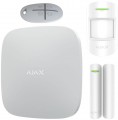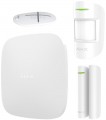Add to comparison |  |  |
|---|---|---|
| Ajax StarterKit Plus | Ajax StarterKit | |
| Outdated Product | Outdated Product | |
| User reviews | ||
| TOP sellers | ||
The kit includes a control panel Ajax Hub Plus, a motion sensor Ajax MotionProtect, an Ajax DoorProtect opening sensor and an Ajax Space Control key fob. Possibility to connect up to 150 sensors. 3G support. | The kit includes a control panel Ajax Hub, a motion sensor Ajax MotionProtect, an Ajax DoorProtect opening sensor and an Ajax Space Control key fob. | |
| Type | alarm system | alarm system |
| Connecting sensors | wireless | wireless |
| Wireless zones | 150 | 100 |
| Backup power | 16 h | 15 h |
| Communication protocol with sensors | Jeweller | Jeweller |
Connection to control panel | ||
| Max. wireless sensors | 150 | 100 |
| Sensor communication range | 2000 m | 2000 m |
| Key fobs communication range | 800 m | 800 m |
| Users (numbers to call) | 99 | 50 |
Complete with central | ||
| Motion sensors | 1 | 1 |
| Opening sensors | 1 | 1 |
| Control fobs | 1 | 1 |
Sensor characteristics | ||
| Motion sensor | Ajax MotionProtect | Ajax MotionProtect |
| Opening sensor | Ajax DoorProtect | Ajax DoorProtect |
| Horizontal angle of coverage | 88.5 ° | 88.5 ° |
| Vertical coverage angle | 80 ° | 80 ° |
| Motion sensor range | 12 m | 12 m |
| Opening sensor threshold | 20 mm | 20 mm |
| animal immunity | ||
General | ||
| Control | control fob phone (GSM) mobile app (Wi-Fi) | control fob phone (GSM) mobile app (Wi-Fi) |
| Operating temperature | 0 °C ~ +50 °C | 0 °C ~ +50 °C |
| Max. humidity | 80 % | 80 % |
| Control panel dimensions (HxWxD) | 163x163x36 mm | 163x163x36 mm |
| Motion sensor dimensions (HxWxD) | 110x65x50 mm | 110x65x50 mm |
| Opening sensor dimensions (HxWxD) | 90х20х20 mm | 90х20х20 mm |
| Key fob dimensions (HxWxD) | 65x37x10 mm | 65x37x10 mm |
| Added to E-Catalog | january 2019 | february 2018 |